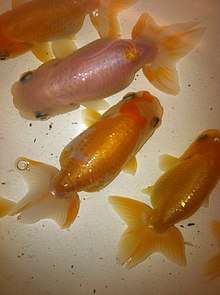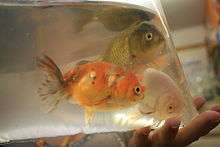Ranchu
The Ranchu (蘭鋳, 蘭虫, 卵虫, ranchū, "Dutch worm") is a hooded variety of fancy goldfish developed in Japan.[1] It is referred to as the "king of goldfish" by the Japanese.[2] This breed has also been historically referred to as the Maruko or Corean Goldfish.[3] However, today, Maruko more commonly refers to the egg-fish goldfish.[4]
| Ranchu |
|---|
 |
| Country of origin |
| Japan |
| Type |
| Fantailed |
| Breed standards |
| BAS |
Origins and evolution
The modern-day ranchu is a Japanese development of the lionhead.[1] They are the direct outcome of crossbreeding experiments of different Chinese lionhead specimens.[2]
- Orange Ranchu goldfish.
 Black Ranchu goldfish.
Black Ranchu goldfish. Blue Ranchu goldfish.
Blue Ranchu goldfish.
Description and standards
The ranchu is a highly regarded fancy goldfish in Japan. Compared to lionheads, ranchus have a more downturned tail and tail fin.[1] Although similar to lionheads, ranchus have more-arched backs and have much shorter tails that are tucked-in at a 45 degree angle.[5]
A ranchu has an egg-shaped body with a deep belly that is between 5/8 to 3/4 the length of the fish. This goldfish does not have a dorsal fin and breeding standards require that the back should not have any vestiges of the dorsal fin on it. The back should be rounded and not flat, as in the case of lionheads. The area of the caudal peduncle should curve sharply downwards to meet the tail. The caudal peduncle itself should be broad and neither lengthy nor too short (a properly formed caudal peduncle avoids swimming motion impairments to this type of goldfish). The ranchu's tail meets the caudal peduncle at a forty-five degree angle, giving the fish a unique swimming motion. Furthermore, the tail lobes are rounded, and all other finnage are paired.[2]
The most prominent feature of the ranchu is its head. There must be sufficient space between the eyes, and also from the eyes to the front of the head. The gill cover should figuratively extend quite far towards the tail. The headgrowth should seem to begin from the bottom of the gill cover and move upward.[5] The headgrowths of young ranchu fry may take at least a year to develop.[1] Young ranchus possessing broad foreheads and square noses generally produce better headgrowths.[5] Mature ranchus can reach between 6 and 8 inches (15 to 20 centimeters) in length.
Ranchus may come in orange, red, white, red-and-white, blue, black, black-and-white, black-and-red, natural, and chocolate coloration. Scalation may either be metallic, nacreous (calico) or matte.[2][5] Ranchus with a pale-yellow bodies and bright red heads are rare.[2]
Ranchus are well-adapted to water quality and pH fluctuations.[5]

Classification, deportment and conformation
Japanese, Thai, American and British ranchu breeders, as well as many prestigious goldfish-keeping societies, all adhere to two strict viewing classifications of the ranchu, namely: the top-view ranchu comportment and the side-view selection criteria.[2][5][6][7][8] But Japanese aesthetic standards for ranchus are more exacting. Ranchus are often compared to sumo wrestlers, as the ranchu is a rounded fish with a headgrowth, also known as a "bramble-head".[2][5] However, traditional Japanese culture, aesthetics and concepts regard these attributes of both ranchu and sumo wrestler as an imposing and solid figure composed of massive circles and squares, which are abstract representations of balance, proportion, dignity, graceful movement and power.[5]

Top-view ranchu (TVR)
In ancient China, people kept goldfish in large jars made of pottery or porcelain; therefore the only way people could see the fish was from the top. For this reason, people selected those goldfish, generations by generations, with big belly, big wen, and dragon eyes genes for the purpose of top view. Therefore, the top view ranchu is considered better aesthetically in Japan and China. The TVR should have a rectangle shape, short tail, and big wen on the head. When swimming, their appearance should resemble a worm moving in water, which gives the ranchu its name (in Chinese "ruan chong" means "egg shape worm"). [5][2][9]
Side-view ranchu (SVR)
A ranchu's back (seen from the side) is compared to a traditional Japanese comb, which comes in two shapes. The first comb-shape (the nagate or long style) is long with rounded corners and is similar to the koban coin. While the second comb-shape (the marute or the round style) is shorter, round and is similar to a round coin viewed from the side, but still not as round as any modern-day circular coins. Both comb shapes are acceptable in ranchu exhibitions and competitions.[5][2][9]
Selection and judging
Most goldfish shows and competitions judge ranchus in an aquarium setting, and judges view the fish from the side and the top, taking note of the fish's comportment and conformation to physical standards, motion and movements. The attachment of the tail to the caudal peduncle are also meticulously evaluated.[2] True Japanese ranchu are judged from above in shallow bowls and definitely not in glass tanks, although the overall shape of the ranchu is taken into account it is the top view that is the most important. Western goldfish societies still tend to use glass tanks for judging but a number of societies based on Japanese methods are now operational and try to follow the traditional way the ranchu are bred, kept and judged. True Japanese ranchu enthusiasts do not keep their ranchu in glass tanks but in shallow ponds or vats.
References
- Andrews, Dr. Chris. "An Interpet Guide to Fancy Goldfish", Interpet Publishing, 2002. - ISBN 1-902389-64-6
- "GFSA - Ask the Judges", an article about the Lionchu by Larry Christensen, Peter Ponzio, Scott Taylor, Tony Reynolds and John Parker, from the Goldfish Pages Website (Goldfish Society of America), date retrieved: 27 May 2007
- Wolf, Herman (1908). Goldfish Breeds and Other Aquarium Fishes, Their Care and Propagation: A Guide to Freshwater and Marine Aquaria, Their Fauna, Flora and Management. With 280 Explanatory Illustrations, Printed with the Text. Innes & sons. p. 11.
- "EGGFISH". Bristol Aquarists' Society. Bristol Aquarists' Society. Retrieved 13 October 2018.
- Johnson, Dr. Erik L., D.V.M. and Richard E. Hess. "Fancy Goldfish: A Complete Guide to Care and Collecting", Weatherhill, Shambhala Publications, Inc., 2006. - ISBN 0-8348-0448-4
- "Goldfish Connection - Types of Goldfish: Ranchu, date retrieved: 22 May 2007". Archived from the original on 2007-04-16. Retrieved 2007-05-23.
- NEO Ranchu Classification and Standards, date retrieved: 22 May 2007 Archived November 13, 2007, at the Wayback Machine
- Thai Ranchu Centre Ranchu Standards and Grading, date retrieved, 22 May 2007 Archived May 19, 2007, at the Wayback Machine
- "What is a Lionchu?" by Peter Ponzio, an article from the Goldfish Pages Website (Goldfish Society of America), date retrieved: 26 May 2007